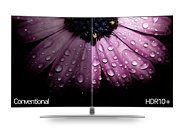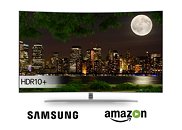Thursday, April 20th 2017
Samsung, Amazon Unveil Yet Another HDR Standard
And here I was thinking the whole point of having standards was to homogenize offerings for a given feature, ensuring the same minimal requirements were met by anyone (or any product) looking to carry a sticker emblazoning its capabilities. Yet here it is, another HDR standard, which Samsung and Amazon are calling HDR10+.
The HDR10+ standard looks to slightly bridge the gap between the HDR10 standard as certified by the UHD Alliance, and the Dolby Vision one, which boasted better HDR reproduction whilst carrying higher specifications to be adhered to. The greatest change in HDR10+: the adoption of Dynamic Tone Mapping, which stand upon variable dynamic metadata to help adjust brightness and contrast in real time, optimized on a frame-by-frame basis, a feature present in Dolby Vision but lacking on the UHD Alliance's HDR10, which resulted in some overly darkened bright scenes.The presence of both Samsung and Amazon in this announcement isn't fortuitous: a hardware manufacturer and a content provider are, in this case, holding hands in delivering an improved experience and an ecosystem adapted to this new standard. For one, Samsung's 2016 UHD TVs will get HDR10+ support through a firmware update during the second half of 2017 (all of Samsung's 2017 UHD TVs, including its premium QLED TV lineup, support HDR10+.) This ensures hardware support for new HDR10+ content, where dynamic metadata needs to be included within a video file before it can be decoded, hence relying upon content creators adopting it - and Amazon is one of the prime content providers for the latest technologies. What a happy coincidence.
Source:
News @ Samsung.com
The HDR10+ standard looks to slightly bridge the gap between the HDR10 standard as certified by the UHD Alliance, and the Dolby Vision one, which boasted better HDR reproduction whilst carrying higher specifications to be adhered to. The greatest change in HDR10+: the adoption of Dynamic Tone Mapping, which stand upon variable dynamic metadata to help adjust brightness and contrast in real time, optimized on a frame-by-frame basis, a feature present in Dolby Vision but lacking on the UHD Alliance's HDR10, which resulted in some overly darkened bright scenes.The presence of both Samsung and Amazon in this announcement isn't fortuitous: a hardware manufacturer and a content provider are, in this case, holding hands in delivering an improved experience and an ecosystem adapted to this new standard. For one, Samsung's 2016 UHD TVs will get HDR10+ support through a firmware update during the second half of 2017 (all of Samsung's 2017 UHD TVs, including its premium QLED TV lineup, support HDR10+.) This ensures hardware support for new HDR10+ content, where dynamic metadata needs to be included within a video file before it can be decoded, hence relying upon content creators adopting it - and Amazon is one of the prime content providers for the latest technologies. What a happy coincidence.


13 Comments on Samsung, Amazon Unveil Yet Another HDR Standard
I don't know why you would even think otherwise.
"HDMI manufacturers pay an annual fee of US$10,000 plus a royalty rate of $0.15 per unit, reduced to $0.05 if the HDMI logo is used, and further reduced to $0.04 if HDCP is also implemented."
en.wikipedia.org/wiki/HDMI
It's very unlikely for community-originated solution to become a large industry standard in electronics. Almost each of the "standards" were started by large manufacturers (often as joint venture).
Even the ubiquitous USB is protected by a (non-free) license.
And here's a interesting difference: if you're making a HDMI cable, you're getting a discount for adding HDMI logo. It's exactly the opposite with USB, where you have to pay extra to put a USB logo on your product. :D
This is a beautiful example of a difference between a dominating and well-known product VS one that still fights for market share and recognizability. :D
The main difference was that metadata was static in HDR, now it isn't anymore.
Oh, and did I mention you don't need to pay Dolby (or anyone) for every device/software that is using HDR10+ just for supporting it?
To my knowledge LG is the only TV manufacturer that bothered supporting Dolby (on top of HDR10 of course). But given the price of its OLED tvs, it's peanuts for them anyhow.They don't have to be open, but given that we have HDR10 that is free, no thanks (and f*ck you, Dolby)
The "we invest a couple of millions into standard to shave off billions for nothing later on" crap needs to stop. (and I'm glad Samsung and Sony bothered)No, that's a different thing (encoding based).
The HDR10 vs Dolby is how you communicate that to a device.
Since expectations are that device max brightness/whatever will vary a lot, "additional work" is needed to map from source to device in an optimal way.There are only 2 standards, OK, this one is 3rd, next to nobody supports Dolby and good luck taking on standard established by actual TV manufacturers (and available loyalty free)
You should care more about actual capabilities of the thing with "HDR" label, as it can very wildly.
as for the thing with standards:
(from xkcd.com/927/)
HDR10 is a royalty free standard (and Samsung is one of the creators).
It didn't support dynamic metadata, but were working on adding it, here is an article from 2016:
www.flatpanelshd.com/news.php?subaction=showfull&id=1463138030
Dolby Vision already had these standards but HDR10 didn't cover them. UHD Alliance seams to not take them into consideration until the majority of their body agrees on them. There is a gap between innovating new way to meet higher set standard and them being accepted.
If you recall Samsung had been pushing HDR 1000 for nits capability and with the QLEDs they are pushing HDR 1500 & HDR 2000 which puts them closer to DV territory.
LEDs were already capable of +1000 but they looked horrid without local dimming grids. OLED just cant get bright enough to reach 1k let alone DV at 4k and who knows what comes next HDR12 ?nits & DV 10k nits and thats just one aspect of the standards.